Home
/ Blog /
Virtual Classroom - The Definitive Guide for 2022Virtual Classroom - The Definitive Guide for 2022
May 24, 202219 min read
Share
If everyone in the world can watch The Witcher 3 being played in real-time by a gamer in South Korea, there is no reason we cannot take lessons from professors at Yale irrespective of where we are located.
What do we mean by Virtual Learning through Live Classrooms?
A live classroom is an online teaching and learning environment in which an educator (teacher, trainer, instructor) interacts with students in real time for the purpose of imparting knowledge. Teachers present and discuss course materials (some of which can be pre-recorded), allocate assignments (individual or group work), clarify students’ questions, and generally replicate the experience and benefits of traditional face-to-face pedagogy.
Live online classes take place in a synchronous setting and much like remote work, have become commonplace since the pandemic. It continues to be the norm in major universities across the world thanks to the recurring waves, and clearly, this mode of learning is here to stay.
Even without the pressures of a pandemic, the many advantages of live classrooms have made them a major player in education. For example, with internet connections being rapidly established beyond just densely populated areas, individuals living in remoter regions can now access quality education with just an internet-enabled mobile device.
In this article, we’ll explore the many facets of virtual learning; the tools required to successfully live stream classes, and which online video education platforms can help teachers and educators get started with conducting classrooms live.
Note: While this article largely includes information valuable to teachers, it will also break down the options available to product managers and developers seeking to build an EdTech app of any kind.
Is Virtual Learning the Future of Education?
To answer quickly, yes.
While virtual learning has been around for years now (starting with distance learning courses), seeing them as legitimate has been a relatively recent phenomenon. Entire websites devoted to online learning have emerged because of how popular the phenomenon has become. The reasons behind this are many — as discussed in the next section — and they require serious consideration.
Much like how remote work was considered an outlier before the pandemic (but has since become a norm), live classrooms have revealed their many benefits since 2020. In a world where the internet allows (and internet users demand) a global exchange of information, education can no longer be constrained by the limitations of the traditional classroom setup. If everyone in the world can watch The Witcher 3 being played in real-time by a gamer in South Korea, there is no reason we cannot take lessons from professors at Yale irrespective of where we are located.
The perception of virtual learning has also changed monumentally in the recent past. While online courses and degrees were largely viewed with suspicion even a few years ago, courses from websites like Udemy are now considered legitimate by prospective employers. Many companies now encourage and incentivize employees to invest in such courses and widen their knowledge base and skill set.
With the world’s most prestigious universities, colleges, and schools switching to online classes, the legitimacy of virtual learning cannot be disputed. While there may be some disadvantages about the lack of in-person interaction among students themselves, teaching and imparting knowledge over the internet is entirely possible and in some cases, highly favored.
Importance of Live Streaming Classes
The importance of being able to live-stream classes was truly realized due to the pandemic. Its many advantages have been discussed later in this article which reveals why live online classes can enrich educational experiences not just during anomalies like the pandemic, but also in regular life.
As mentioned above, the explosion in access to the internet across the world has made disseminating information a simple task. Live streaming of classes is the perfect way to democratize education and ensure that those in less fortunate situations have access to courses and classes that help with prospects.
Live classrooms also allow students and teachers to focus on what’s truly important and cut out irrelevant issues like delays caused by traffic, a long and difficult commute, unfavorable weather (too much heat or rain), etc.
Additionally, a live stream can be recorded, which is helpful not just to students who may be absent for some reason but also to anyone who may want to revisit the same class for better comprehension of the subject. Teachers can also use pre-recorded material to provide greater clarity on the subject matter when they cannot explain everything within the set time frame.
The advantages brought to the table by live online classes are numerous, and far-reaching and greatly enrich the educational experience for all parties involved. Teachers have more resources to make lessons interesting and informative, and students can access varied learning materials and set (within reason) their pace/mode of learning.
How to Get Started with Live Online Classes - For Teachers and Educators
If you are a teacher who is about to live stream their first class, this section is for you. To start with, ensure that you have the following in place:
-
A solid internet connection that works uninterrupted for hours at a stretch.
-
Plan out your lessons the same way you would for a traditional class, but make sure that students also have an effective task submission and feedback system. For example, dedicate a portion of the class time to taking questions, either on chat or on video. Similarly, there should be some kind of system for students to submit assignments (maybe over email, but that can be hard to organize) and receive feedback.
-
Have digitized and indexed study materials at hand. Every student should have access to the texts, videos, and other learning collaterals you use during the class.
-
Have an appropriate background. If possible, get a green screen and project a background that is relevant to the class and may interest students.
-
Use learning aids. Just talking to students for an hour will make them lose interest and space out of the discussion. Incorporate videos and images to keep them engaged.
-
When you are sharing your screen, ensure that all irrelevant tabs/windows are closed. You do not want your students to see something untoward/inappropriate in a class.
-
To maintain order within the class, it might be necessary to mute students when you are speaking. This prevents them from bothering other students with unwanted noise. However, this ability (to mute students) may only be available on specific online video education platforms.
-
Google Meet and Zoom may not always be the right option, and choosing the right platform depends on your requirements (muting students, streaming classes to a big audience, etc.) You may require specific virtual classroom software that meets your requirements.
Common Issues Encountered by Teachers when Teaching Online
To get a first-hand idea of the issues educators face as teaching and other academic interactions shifted online, we spoke to a professor of Computer Science at the Indian Institute of Technology, Bombay, India. The discussion provided us with significant insight into issues that must be solved for teachers to be able to conduct online classes that satisfy both teachers and students. A few key issues among them are:
-
Certain tools are not compatible with multiple operating systems, making them a non-option for students/teachers who might work best with those OSes. For example, Microsoft Teams is not adequately compatible with Linux systems, with problems arising in accessing common features like screen sharing. On the other hand, Webex does not allow polling when running on Linux systems but does so on Windows.
-
Platform dependency is an issue, since many tools may work or at least appear differently, depending on the device it is being accessed via. For example, a tool may not be optimized for a Samsung Galaxy M12. Therefore, students using the device may not be able to easily figure out what the features are, or may even have trouble seeing the teacher as expected if responsive design compatibility is missing for that device.
-
Tools like Zoom offers many handy features for streaming a classroom live, but beyond a certain limit (for example, 300 students in a class), the costs involved become exorbitant and are inaccessible to any teacher or educational institution without deep pockets.
-
The effects of buggy code are quite apparent, even in major players in the domain. Teachers and students have to deal with the consequences of such error-prone code, especially when in virtual classrooms with a large number of learners.
-
Often, for optimal performance, most edtech/video conferencing tools tend to consume excessive bandwidth and memory, which makes their usage a challenge for individuals with unstable or limited internet access.
-
There are few-to-no tools that can truly replicate the classroom experience. For example, whether the teacher can quickly redirect a student to a private breakout room to address questions or concerns that would not be appropriate to discuss in front of the entire class (this mimics the experience of the teacher coming to the student’s desk and conversing, or speaking to them outside a classroom). As long as these abilities are not provided by edtech platforms, the online teaching experience will remain inferior to in-person interaction.
-
Tools need to be flexible enough to accommodate requirements of not just a classroom setup, but conferences, webinars, seminars, and other events common in the academic domain. Often, a single tool does not offer the features required by all these scenarios.
-
Depending on the tool, there may not be enough collaborative features (shared whiteboard, for example) for, say, research-based meetings between scholars. While they are not directly streaming classes, this is an absolute necessity for higher educational institutions.
Often, due to these hindrances, teachers end up having to use multiple tools for multiple functions — one for classes, one for sharing material, one for conducting exams, and so on. This makes for a disorganized, inconvenient experience in which the teacher or students end up spending more time figuring out their technology — time that should ideally be used for teaching or learning.
But, given these issues, what are teachers’ current solutions?
Virtual Classroom Software - Self-Hosted vs. Preset Platforms
When starting with live-streaming classes, selecting the right platform is of utmost importance. You have to ensure that whatever tool you choose to conduct live classrooms must accommodate all requirements (present and future) of teachers and students alike. Additionally, it must adhere to organization/institution-specific needs, such as being customizable for branding purposes, offering competitive pricing, etc.
To start with, let’s discuss the two major types of online video education platforms you can use: preset vs. self-hosted platforms.
Preset Platform: Think Zoom or Google Meet. They are preset platforms, meaning that they offer a predetermined set of features and a largely unchangeable UI. There is very little room for customization, which can be a major disadvantage for anyone trying to integrate these platforms into their organization (who may want to place their branding/design specifically on the said platform). Additionally, if there is a feature missing, there isn’t much you can do since once again, these tools offer little to no scope for modification.
Preset platforms are generally suitable for individuals seeking to host classes themselves or organizations that can function adequately with the limited features they provide.
Self-Hosted Platform: Unlike preset platforms, self-hosted platforms allow you to extensively customize features and UI so you get a product tailored exactly (or very closely) to your needs. However, leveraging the full potential of self-hosted platforms like 100ms or Agora requires developer effort.
Take 100ms for example. It provides a codebase that users can clone and deploy on their servers. They can also play with the code as required to implement a wide range of features as required by the specific use case. For instance, with 100ms, users get features like hand-raising and screen sharing right off the bat. They don’t have to write any extra code or put in any extra effort to include it in the final product.
As mentioned above, self-hosted platforms need the intervention of developers to be utilized to their fullest extent. While individual teachers with non-tech backgrounds can certainly use 100ms to host and stream classes (and that too has significant advantages), you may not be able to customize the platform without some coding.
How 100ms Stands Out
100ms is a cloud platform that allows developers to add video and audio conferencing to Web, Android, and iOS applications. It offers SDKs, using which developers can add audio-video communication abilities with just a few lines of code. Its codebase has been created and is maintained and upgraded by the team that built the live video infra at Facebook Live and Disney+Hotstar.
Let’s quickly explore why 100ms would be the best choice for someone looking to create an EdTech app or even to add live-streaming features to an existing educational platform.
Roles
100ms uses a unique concept of roles to simplify live streaming and give teachers greater control over conducting classes.
Roles, in the 100ms ecosystem, refer to a set of permissions that allows each participant to perform certain actions on a call. In the case of live classrooms, roles would decide what the teacher and students can do when they are on the call.
For example, using the role feature, teachers can decide that while they are speaking, students cannot outright interrupt them by speaking but can “raise their hand” virtually to denote they have a question. Once they finish speaking, the teacher can change the student’s “role” so that they can speak up and ask questions.
With the roles’ functionality, teachers can, with a single click, change what students can do when in a class. They can also change the students’ “role” while in a single call, as shown in the example above. Unlike preset platforms, the availability of “roles” allows the conducting of systematic, low-chaos classes with very few interruptions or interference.
HLS Streaming
Note that this function is not offered by Zoom or Google Meet.
As mentioned above, excessive bandwidth and memory consumption can be a deal-breaker when choosing tools for streaming online classes. However, 100ms solves this rather seamlessly by offering audio-video streaming via HLS.
By default, 100ms offers streaming via WebRTC, a video protocol for enabling real-time video, audio, and data communication without any plugins. Simply put, it allows real-time video and audio communication to work inside web pages. Because of its many advantages, it is considered to be one of the most future-forward technologies designed for audio-video interaction.
However, WebRTC has limitations about how many individuals (peers) it can host while on a call. Given the complexity of this technology, it is also relatively expensive to implement and utilize.
To solve this, 100ms allows streaming via HLS, an open specification for delivering media over HTTP which can then be played via HTML5 players. HLS supports robust, reliable media distribution that can scale to hundreds of millions of users with the support of CDNs. That means, if you have to stream your classes beyond a certain number of students (3000, when using 100ms), you can switch to HLS streaming with a single click, and stream to millions.
Additionally, HLS streaming costs 1/4th of what streaming via WebRTC costs. For 100ms users, that translates to $1 per participant per 1000 minutes for HLS streams while WebRTC streams cost $4 per participant per 1000 minutes. And this pricing kicks in AFTER 10,000 free conferencing minutes per month.
Since HLS streaming also consumes far less bandwidth than WebRTC, students don't have to expend as much data to watch/listen to the videos. This is especially useful for locations like most tier-3 cities in India, where people largely use Reliance Jio data packs offering 1.5GB of data per day. By watching HLS streams of live classrooms, they won’t have to use much data for each class, meaning that they can attend all classes and have data left over for other activities.
In the real world, here’s what this would look like for a teacher streaming on 100ms:
As a teacher, once the class starts, you switch your students’ streams to HLS while you stay on the WebRTC stream - easy to do via 100ms’ intuitive dashboard. Students can watch and listen to you but cannot speak or interact. However, they can “raise their hand”.
If students have questions, the teacher can, again with a click, switch the individual student’s “role” over to WebRTC so that they can speak and broadcast their video to you and the class. Once the question has been resolved, you switch them back to HLS, where they can only watch your video.
By this process, teachers and organizations can be more effective with bandwidth management and optimize the learning experience for teachers and students alike. You pay less and get more control over how classes are shaped and what students can take away from the lesson.
How to set up your first Classroom Live Stream with 100ms
To get started with live streaming classes via the 100ms web app, follow these few simple steps:
- Sign in to your 100ms account. If you do not have an account, sign up for free here.
- Log in. You will be directed to the 100ms dashboard.
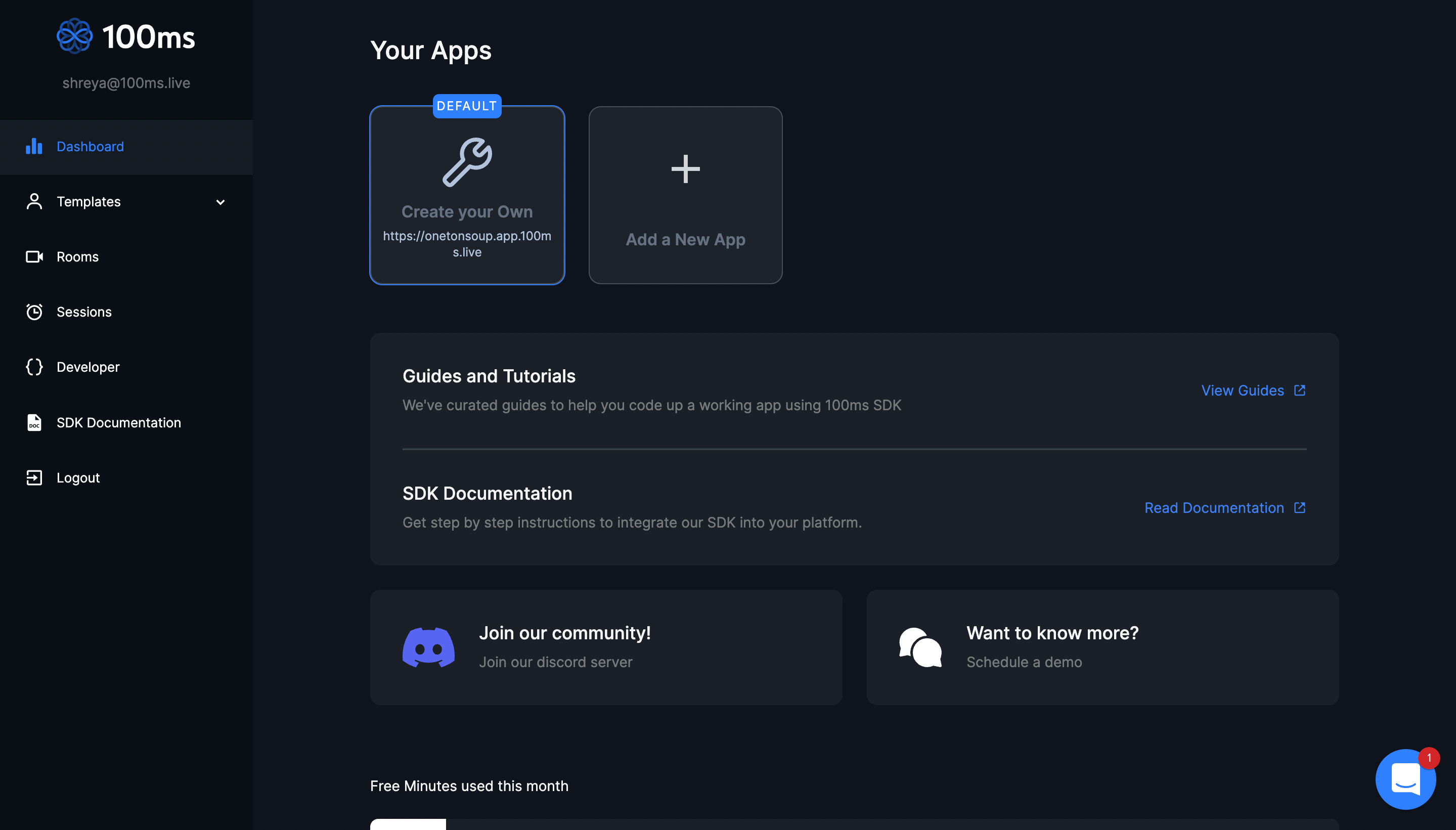
-
In the image above, you can see that a Default app already exists. If you are a first-time user, this will not be the case. You will only see the Add a New App tile. Click on it.
-
On clicking the Add a New App tile, you will be presented with a set of pre-built templates. Since we are going to live stream a class, select Edtech as your template of choice.
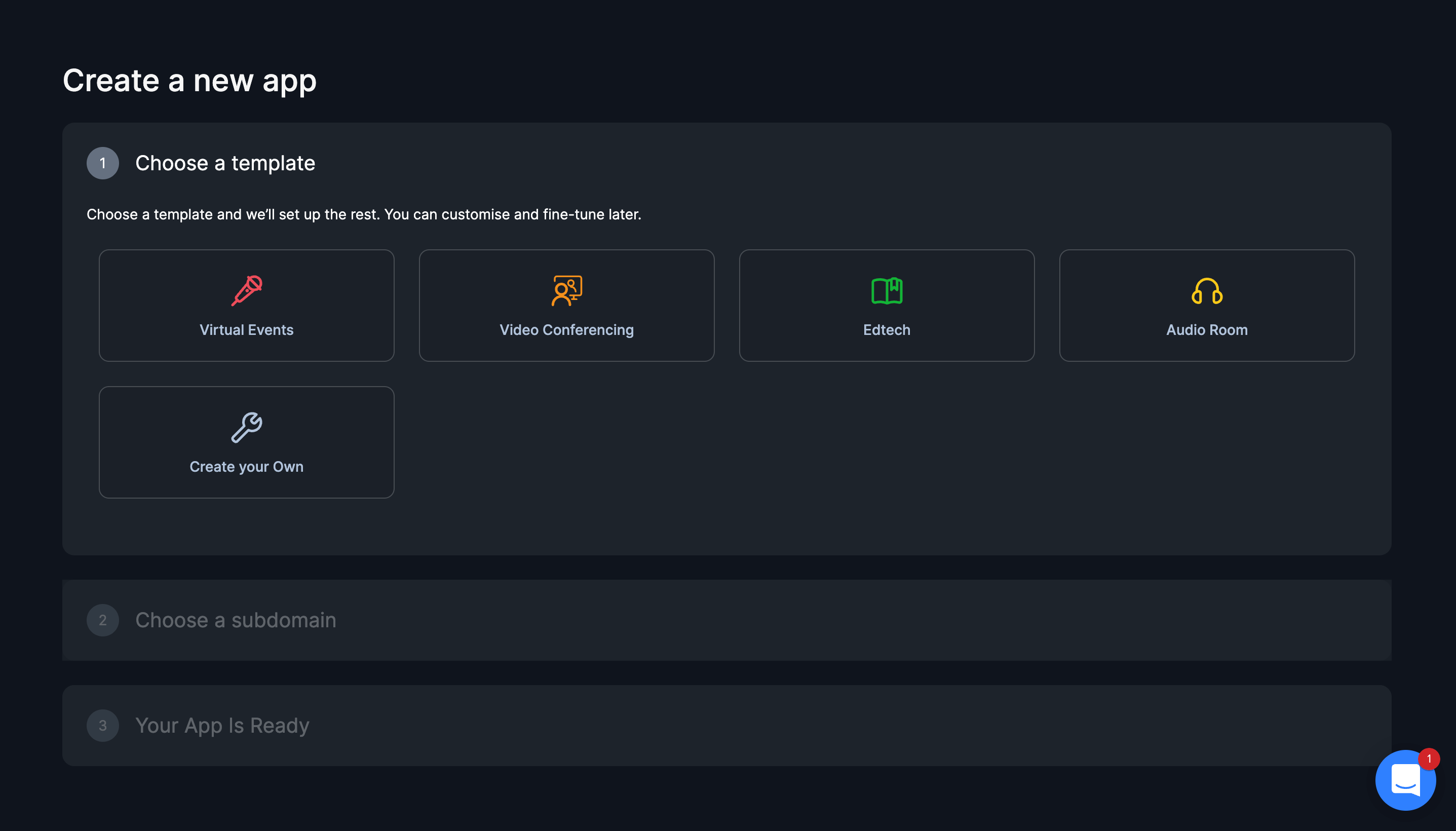
- On selecting Edtech, a Next button will show up. Click on it.
- Next, choose a subdomain name. This will essentially be the name of the “room” where you stream your classes live.
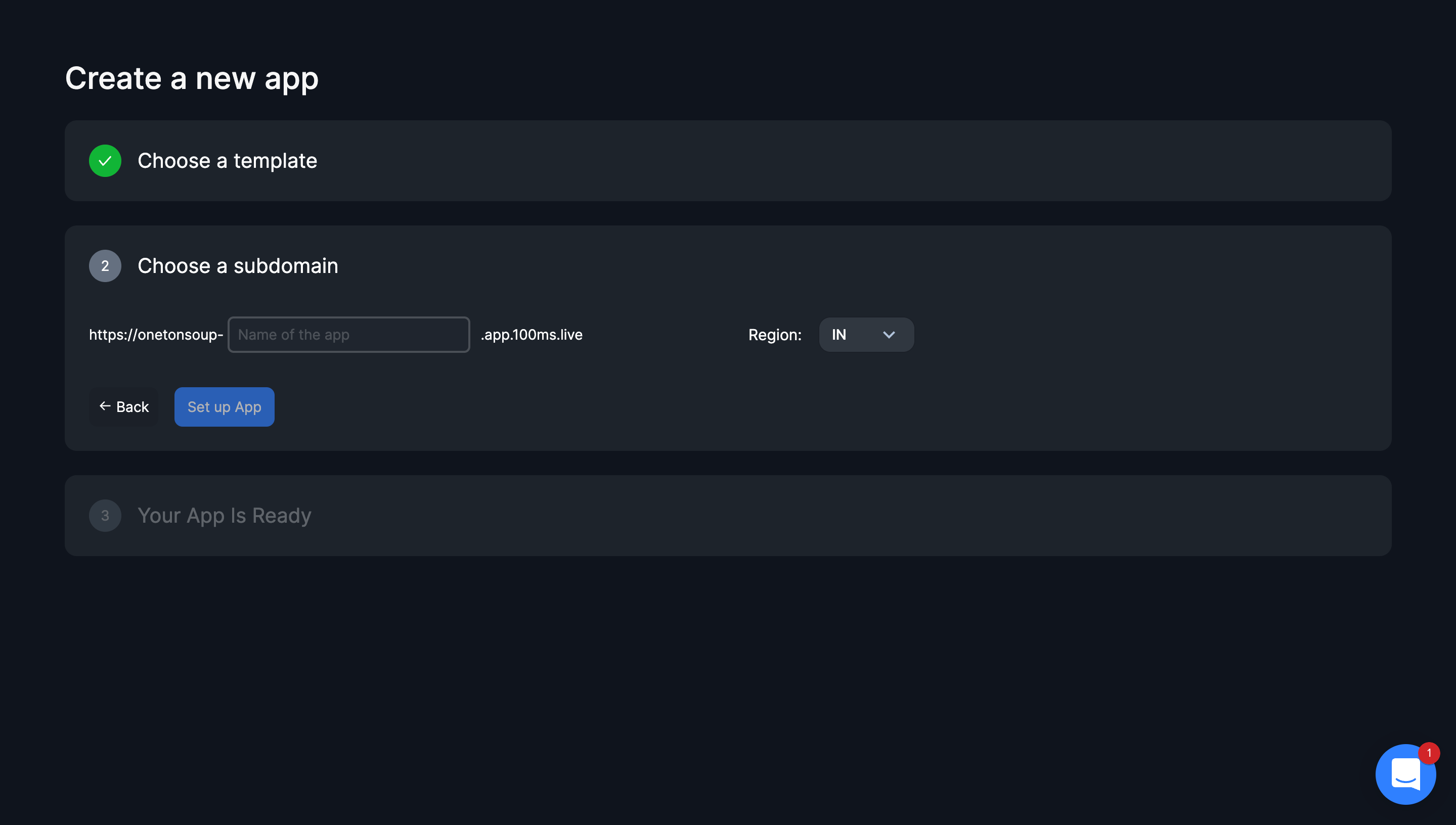
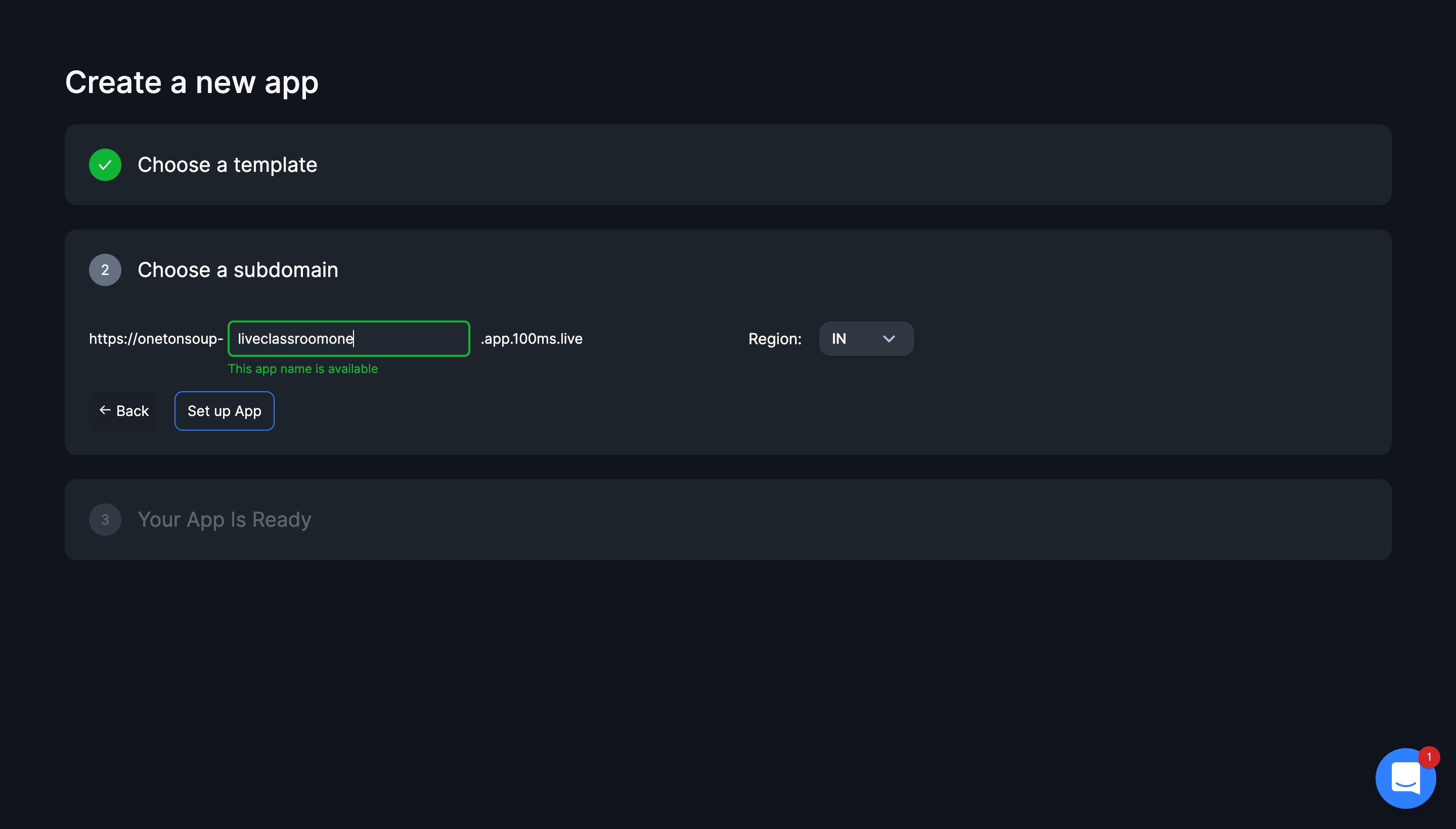
Click Set up App. Once you do, your app is ready!
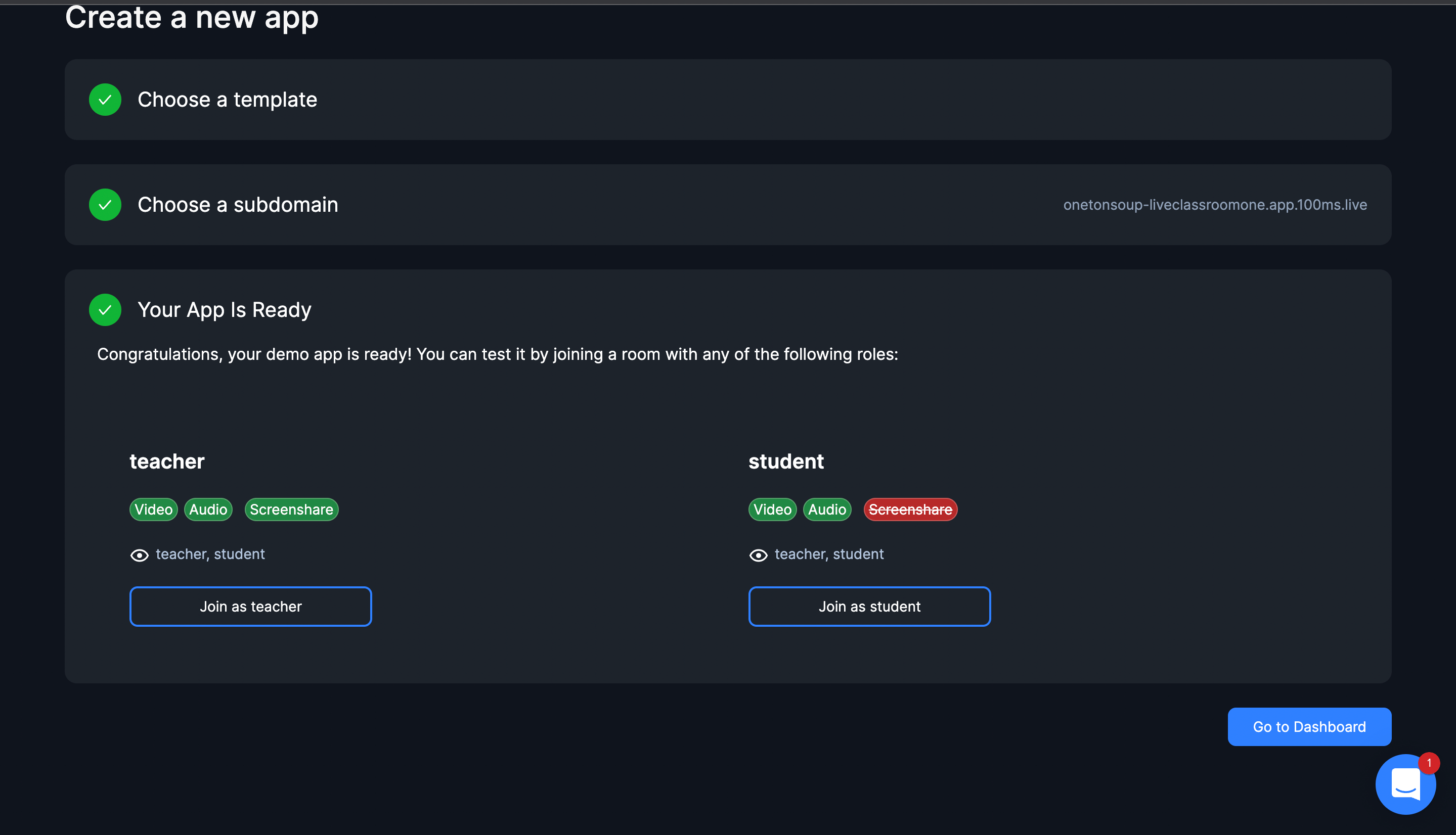
- You can see that there are two roles created with different permissions. The teacher can share video, audio, and their screen, while the student cannot. Click Join as teacher.
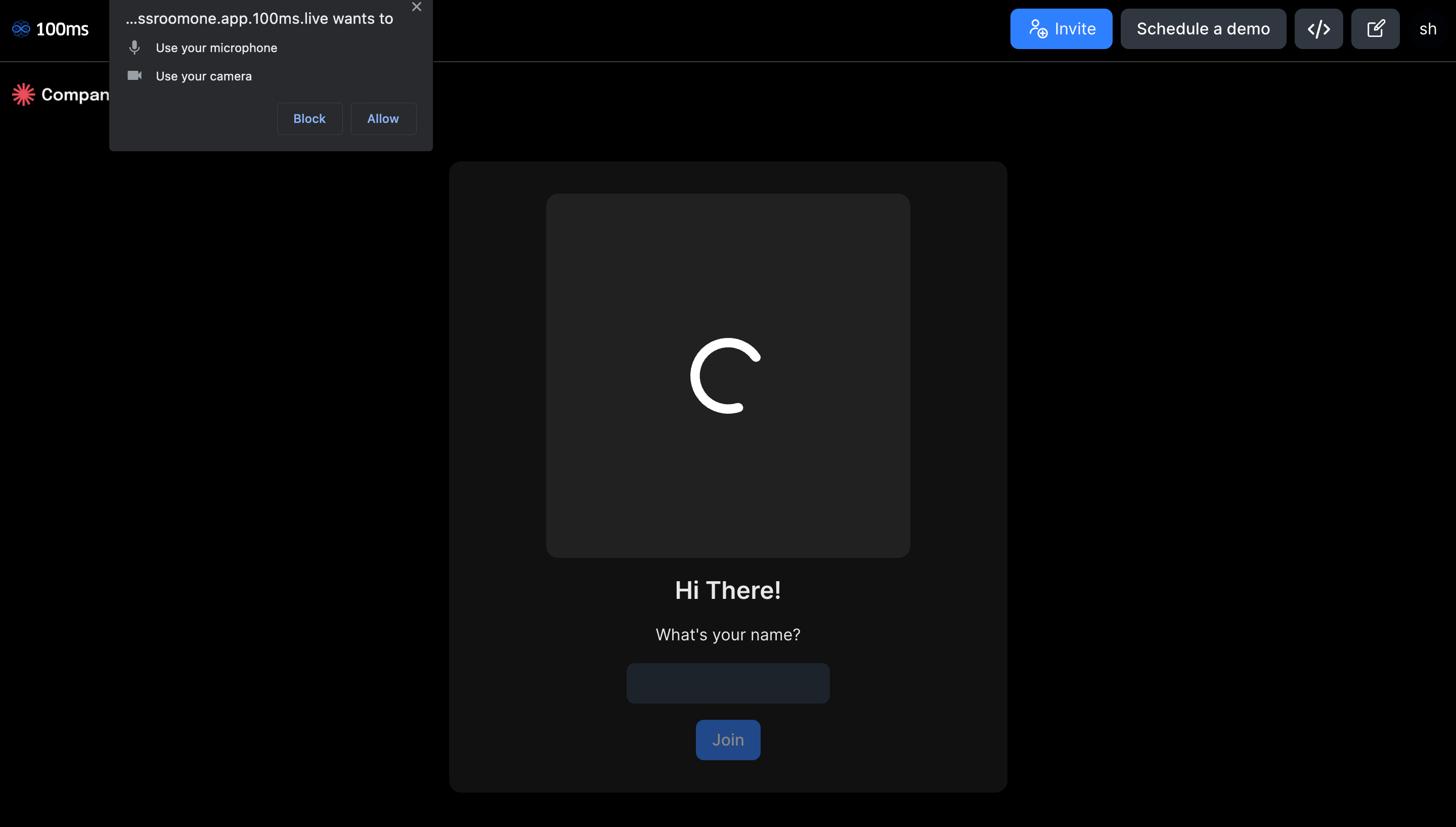
- “Allow” access to your camera and mic, fill in your name, and click Join.
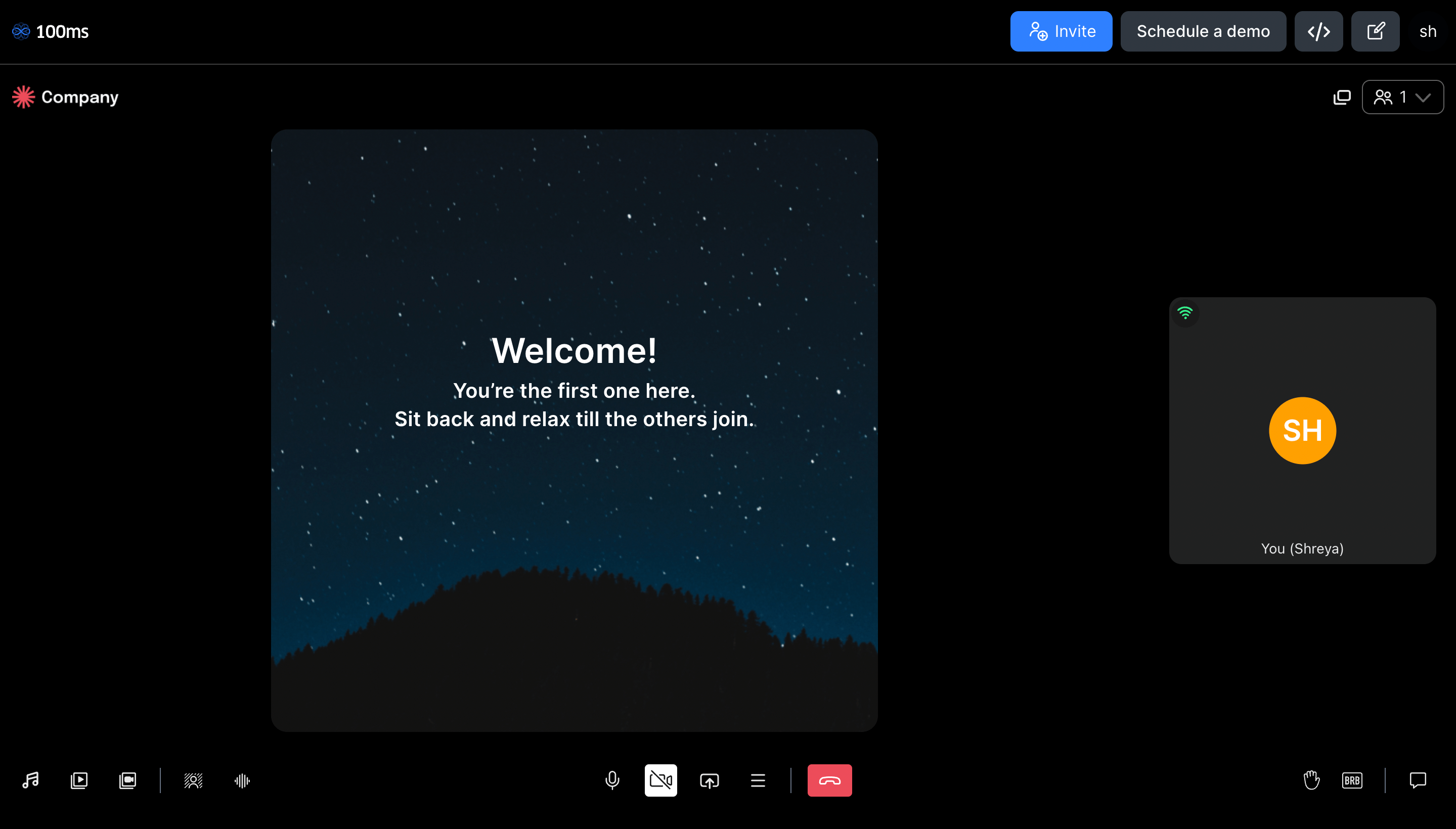
Now, you can invite students into the room.
Inviting Students into your Live Classroom
- Click on the Invite button at the top of your room. It will cause two links to pop up.
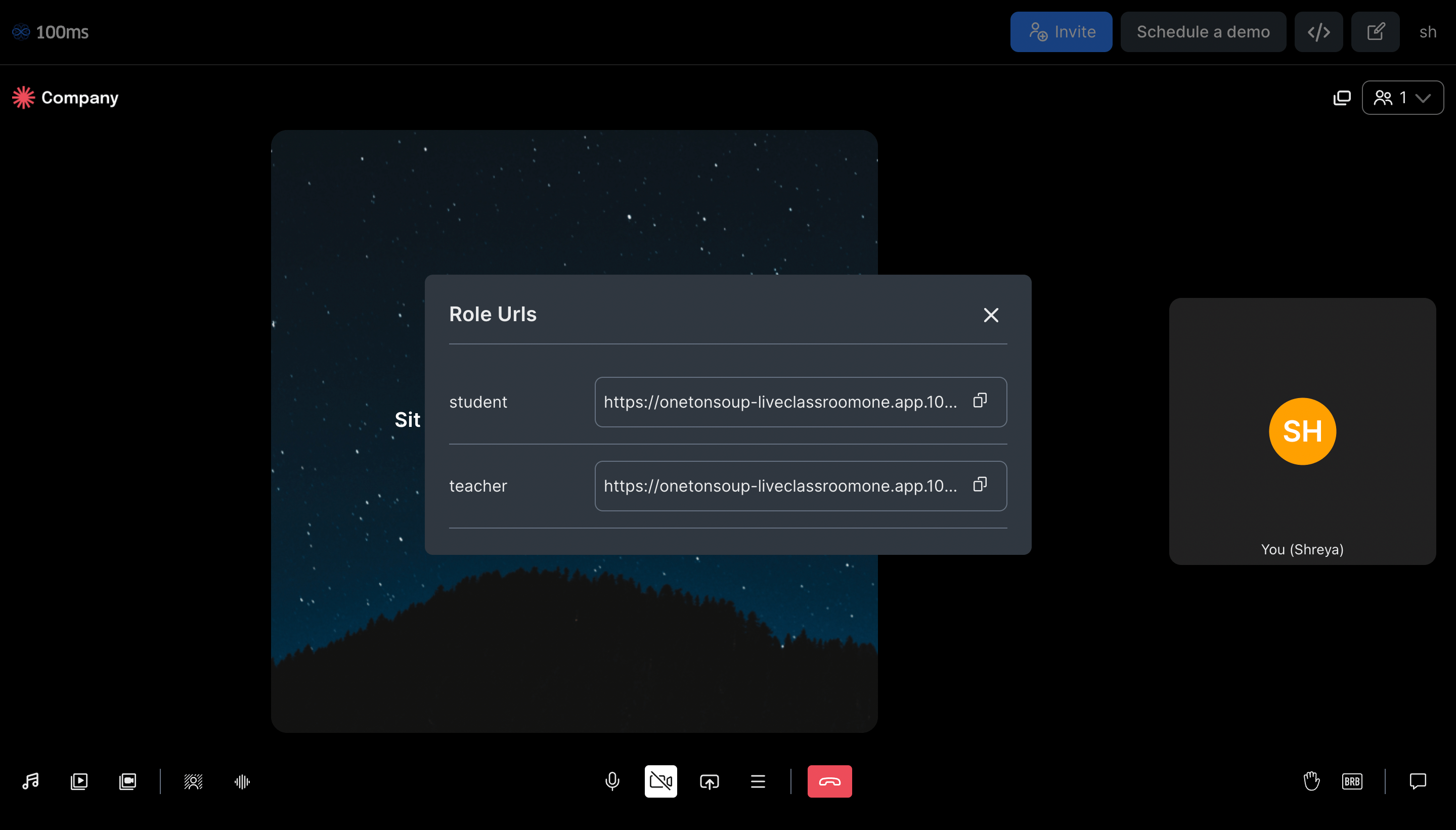
- Copy the link next to “student” and send it to anyone who wishes to attend your live online class.
Customizing your app
You can make a few changes to your app’s appearance directly from the room. Just do the following:
- Click on the edit icon in the top right of your room (highlighted in the image below).
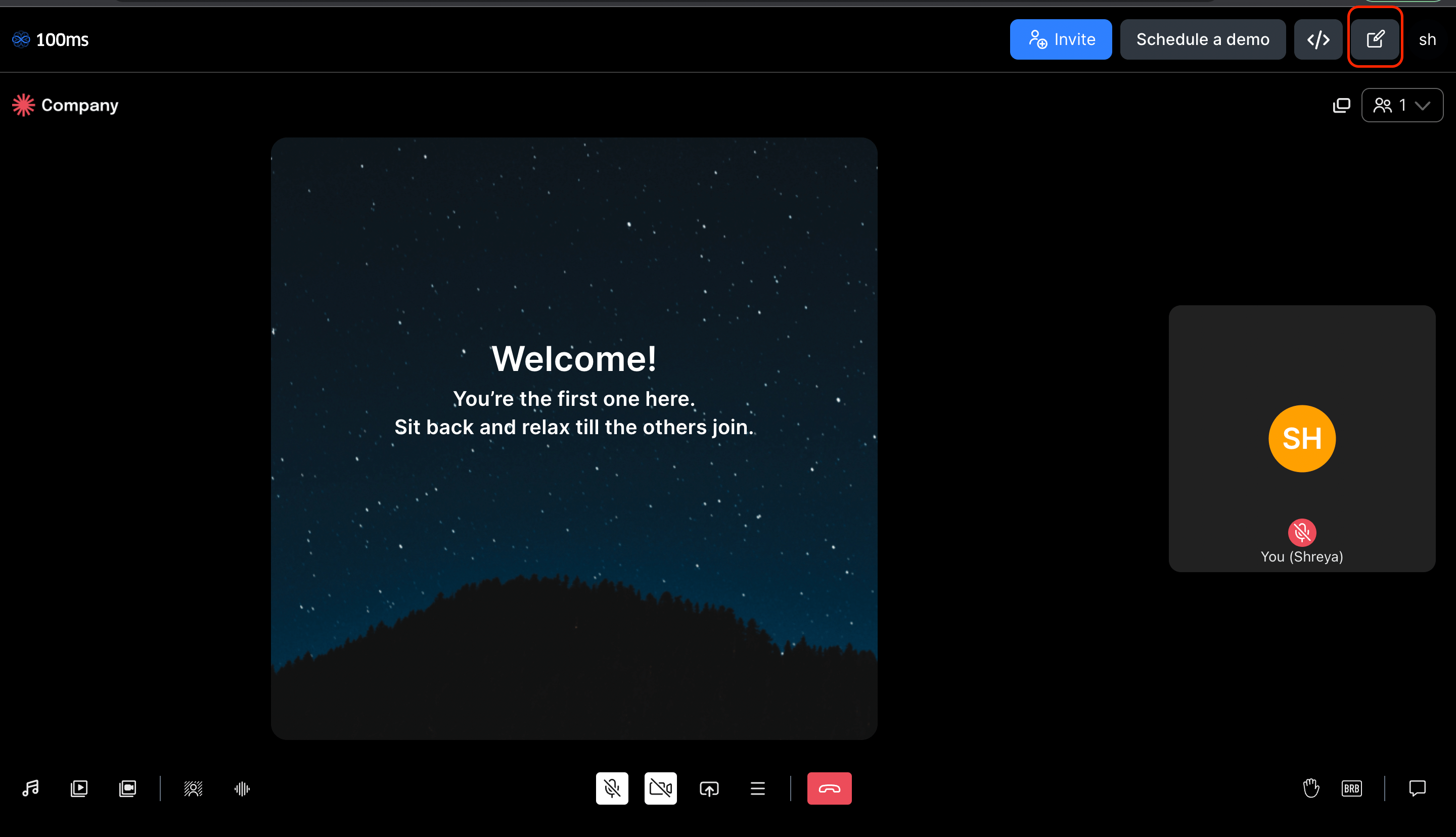
- A menu will show up with multiple options to change the appearance of your room.
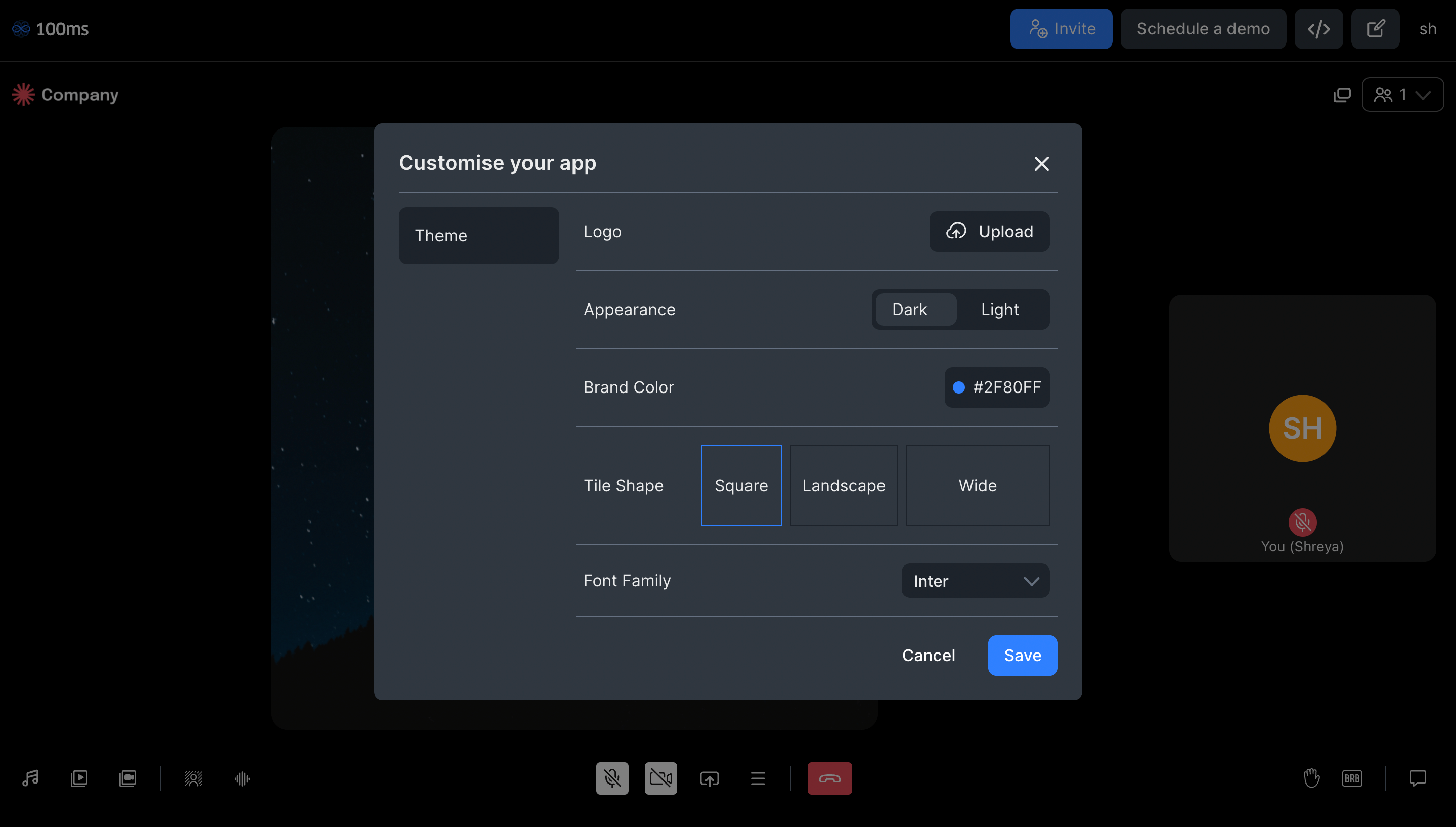
Upload a company logo, and change appearance, brand color, tile shape, and font to personalize the 100ms app to your specifications.
Changing Roles
You can change students’ roles, or even your own quickly and in a simple manner from the dashboard. In other words, you can easily change what you or your students are allowed to do during class with a few steps:
- Go back to the 100ms dashboard. Click on the Templates option in the menu on the left.
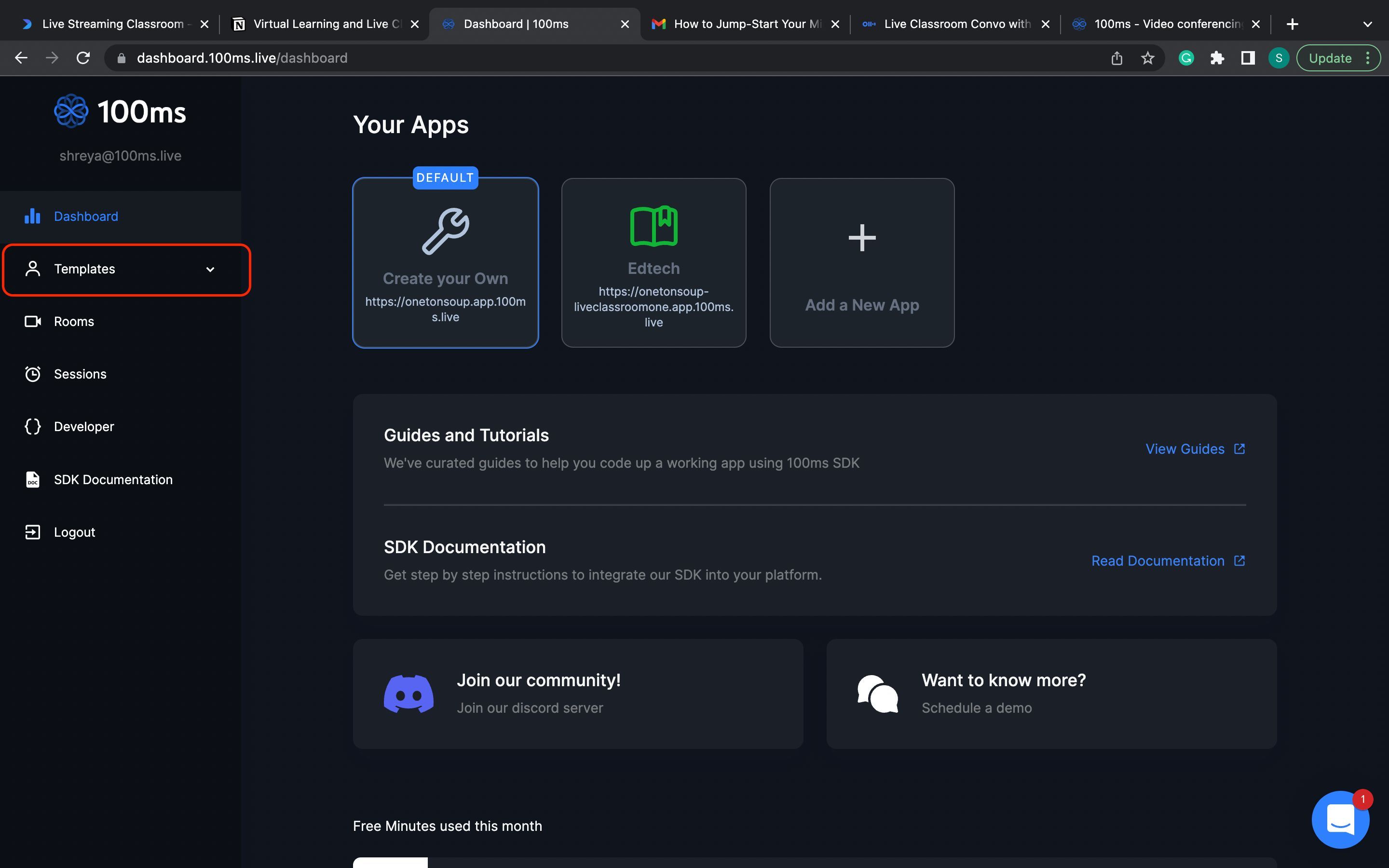
- Once the menu opens, select your Edtech app. Corresponding to your app, you will see several options for role-based permissions, about both you (teacher role) and your pupils (student role).
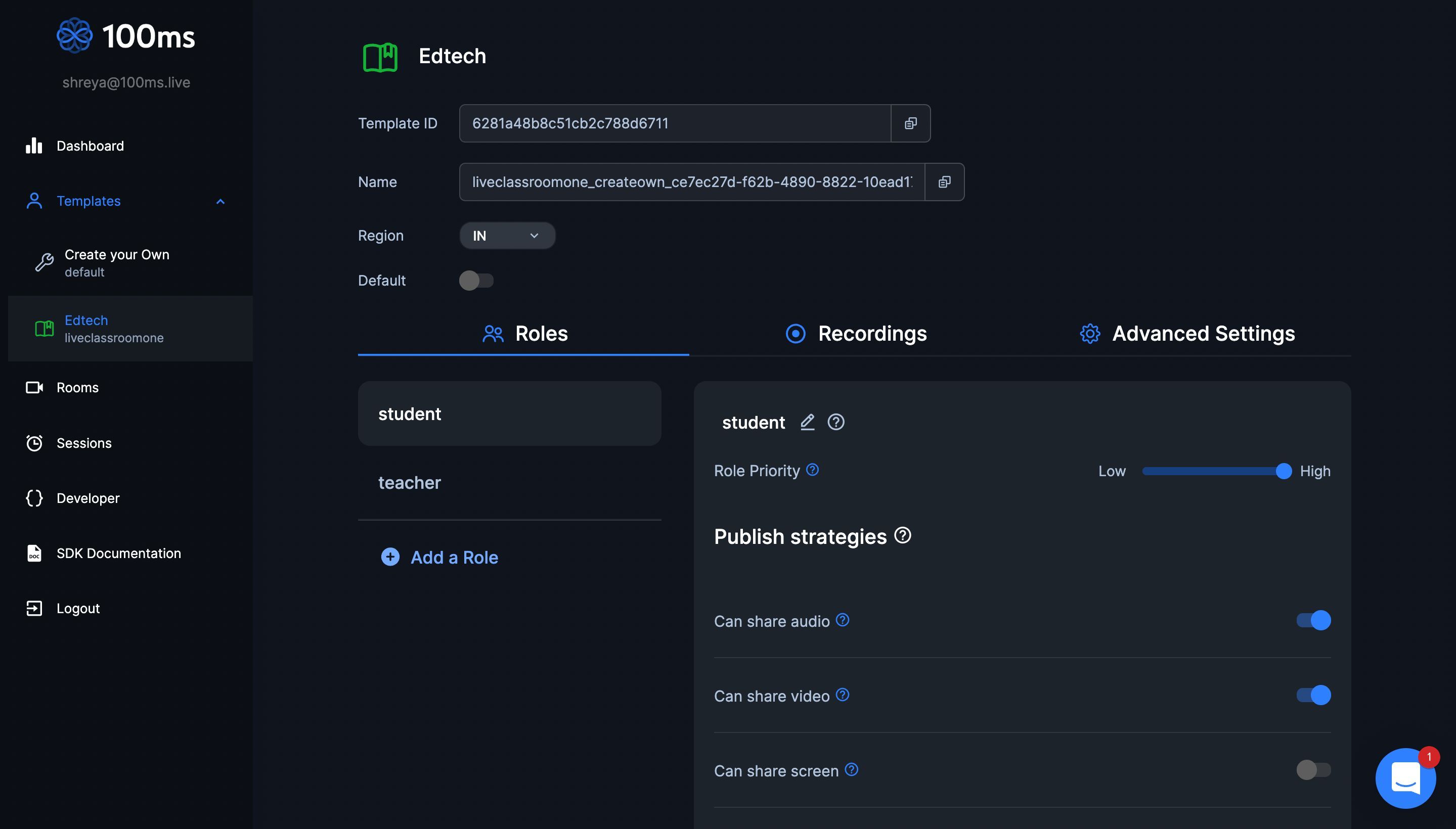
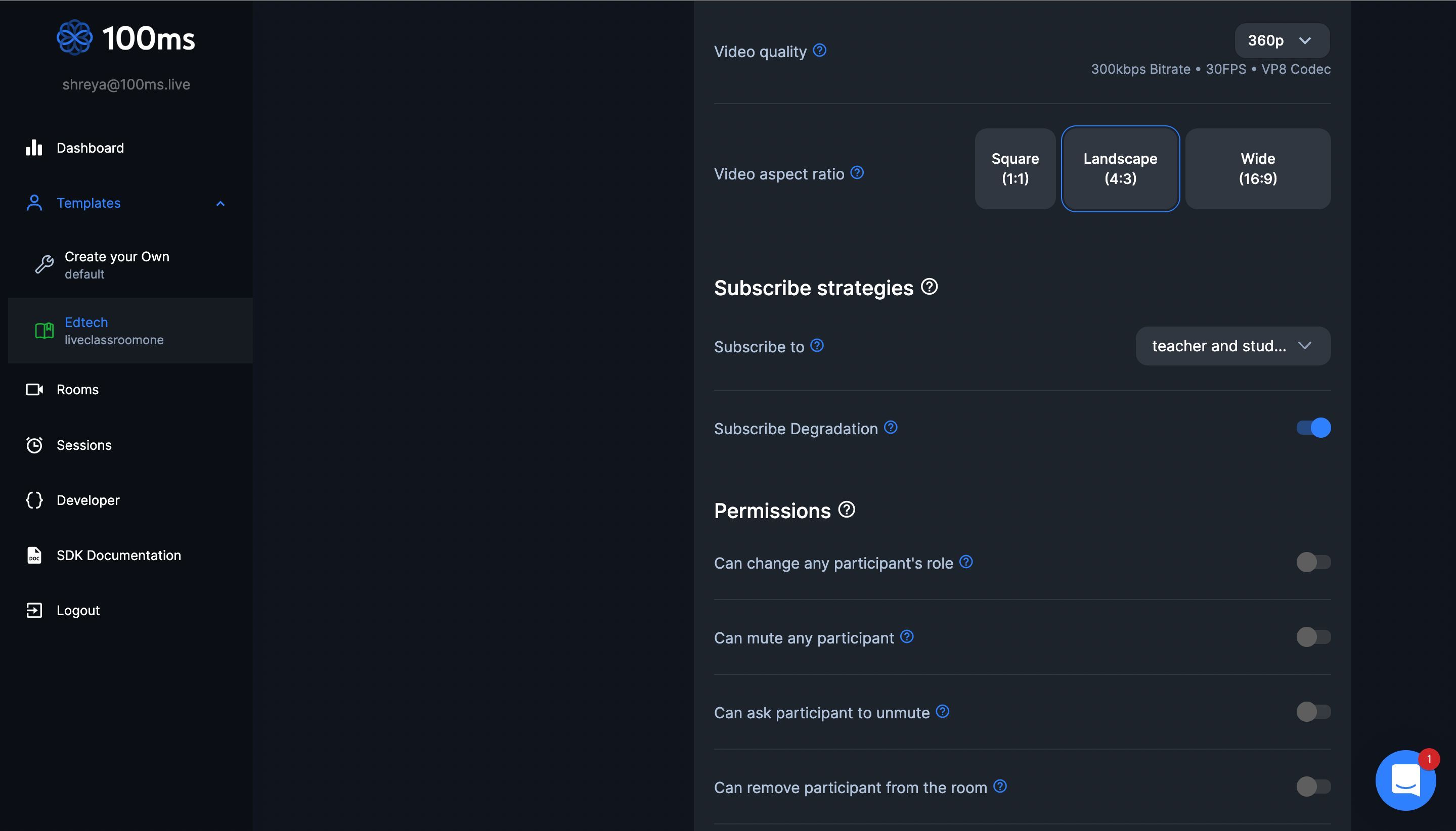
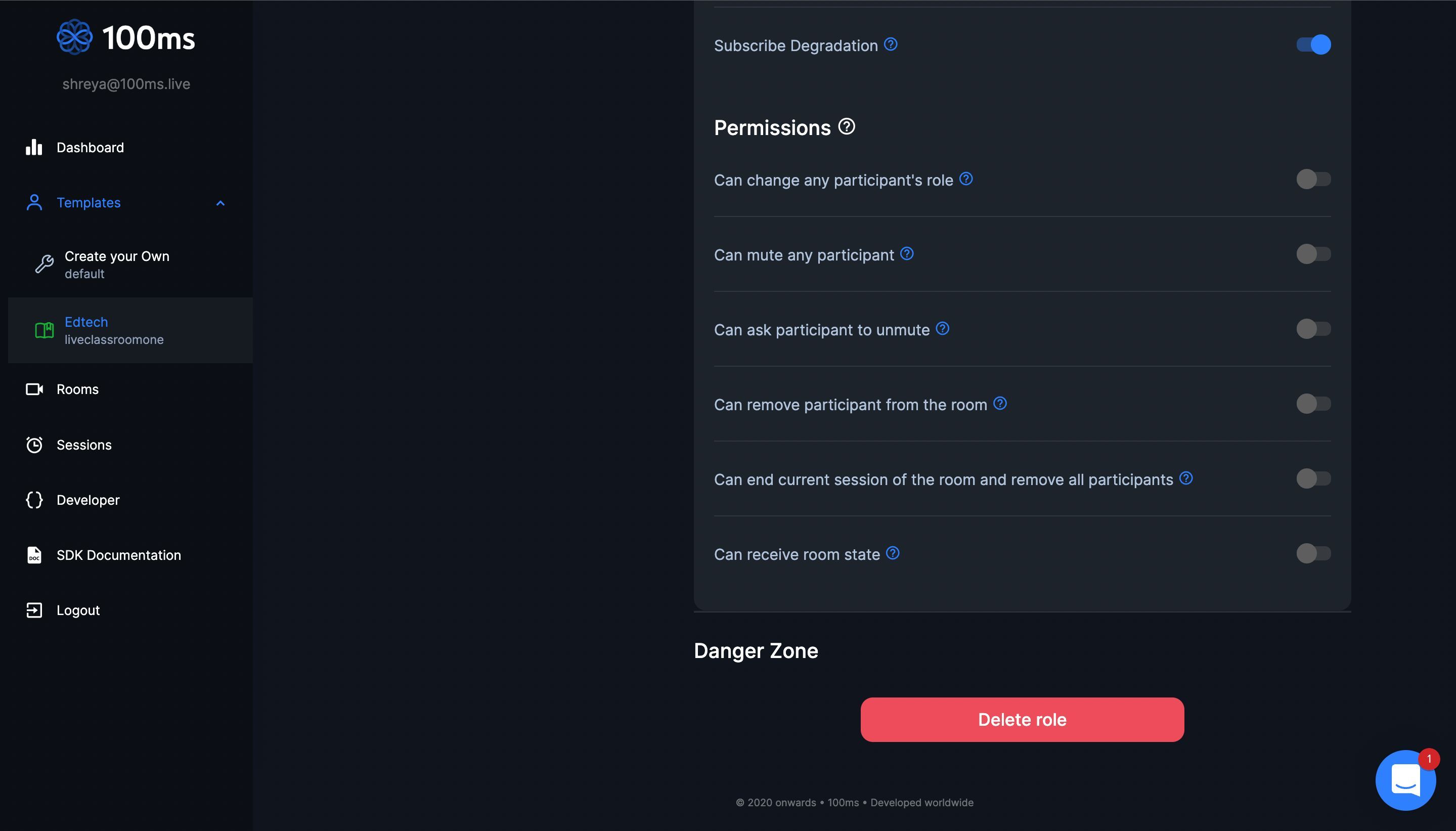
Depending on what you want, you can allow/disallow students from speaking, or sharing videos, or their screens. If you have an assistant to help during the class, you can create a new role for them, and give them permission to mute/unmute students, change their role, etc. Simply use the Add a Role option under the “student” and “teacher” roles seen above.
Top 10 Classroom Live Streaming Platforms
Tip: Take free trials of every tool to figure out which works best for you.
1. 100ms
Built by the team that set up video infra at Facebook Live and Disney+Hotstar, 100ms offers live audio/video SDKs to integrate video conferencing capabilities into any app. However, individual users can also sign up for free on 100ms and get started with live streaming within minutes on the 100ms app itself. All users get 10,000 free conferencing minutes per month.
Features: Pre-defined audio-video templates for multiple use cases, HLS streaming, fully customizable UI, native mobile SDKs, 99.99% guaranteed uptime, 24x7 support at no extra cost, breakout rooms, RTMP broadcast, and much more.
Pricing: Every user gets 10,000 free conferencing minutes per month. ****$1 per participant per 1000 minutes for HLS streams. WebRTC streams cost $4 per participant per 1000 minutes.
2. VPlayed
An end-to-end customizable e-learning platform that allows you to stream educational videos to subscribers.
Features: Buffer-free live streaming via cloud transcoding, HLS player with adaptive bitrate streaming ensures UHD quality video viewing, automatic saving of recorded video in a searchable video library, interactive whiteboards, breakout rooms, polls, 100% customization, multi-screen platform, in-video search.
Pricing: Not mentioned on the website. Contact Sales for exact numbers.
3. Zype
A content management and distribution tool for education providers looking to create video streaming ventures.
Features: Import/upload multiple videos, make bulk metadata changes, organize content into reusable playlists for publishing, automated workflows to reduce repetitive tasks and streamline curation, simple & intuitive CMS dashboard, and ability to launch your apps.
Pricing: Starts from $500/mo and goes up to $5000/mo for the Enterprise plan.
4. Panopto
An online lecture platform designed for universities or large educational institutions.
Features: Integrations with multiple learning management systems, allow the creation of a video library, integrations with authentication systems, dedicated software for capturing lectures, auto-archiving, white-label streaming, and video analytics.
Pricing: The free plan allows 100 hours of streaming a month with 5 hours of video storage. The paid individual plan costs $14.99/mo and offers unlimited streaming. There is an Enterprise plan for organizations, the price for which can be obtained by contacting Sales.
5. Hippo Video
A video streaming hosting provider that allows users to stream classrooms live.
Features: In-built tools for customization, video editing, and quality upgrades, ****features for video hosting, management, collaborating, screen capture, and more.
Pricing: Hippo Video offers differently priced plans for each use case. For example, there are four plans tailored for Sales use cases, 3 plans for Marketing, 3 plans for Customer Support, and 3 plans for Team Communication. For details on all plans (too many to describe here), visit their pricing page.
6. Kaltura
A cloud-based video platform designed to provide a real-time learning experience, both live and video-on-demand.
Features: Offers moderation controls, whiteboard, screen share, content management playlist, interactive real-time quizzes, breakout rooms, HD video sharing, user-level heatmaps, engagement analytics, comparative analyses, and more.
Pricing: Kaltura’s virtual classroom tool starts at $19 while the Enterprise plan carries custom pricing.
7. IBM Cloud Video
This video streaming platform is largely suitable for educational institutions since the plans with necessary features start at $500/mo. It is known for providing professional broadcasting tools that allow for high-quality streaming and class design.
Features: Content management, webcasting, password protection, cloud transcoding, global delivery, HD streaming, and more. Advanced features comprise AI-based speech-to-text, real-time polling & monitoring, automated closed captioning, video analytics, and insights.
Pricing: Plans start from $99/mo (offering only 100 viewer hours) and go up to $999/mo for 5000 viewer hours. Custom plans for high-volume viewership are also available.
8. Brid.TV
This online video platform allows users to host videos, manage a video library, track performance, as well as configure their CMS.
Features: HTML5 player for fast page loading times, extensive video monetization through Brid.TV marketplace, video header bidding at scale, white-label CMS, advertising analytics, WordPress video plugin, and more.
Pricing: Plans start at $24.99/mo with 150,000 video plays to a Premium plan with custom pricing allowing unlimited video plays.
9. Cincopa
Cincopa is a video hosting platform that allows users to store and manage photos, audio, and video. Teachers and educational institutions can use its many features to live stream classes and engage students with visual content such as slideshows, podcasts, and presentations.
Features: Video insights, auto-archiving, adaptive bitrate streaming, developers’ API, multiple integrations with popular tools like Zoom, Mailchimp, Salesforce, HubSpot, etc., mobile-adapted video player, video capture, and more.
Pricing: Plans start from $25/mo to $350/mo for the Enterprise plan.
10. Muvi
Muvi provides an end-to-end streaming platform with dedicated services for education. It provides on-demand & live streaming video solutions for universities and educational institutes.
Features: Single CMS dashboard for management, support for multiple monetization techniques, customizing timeframes and view numbers for each session, adding downloadable study material, DVR-enabled live stream, support for RTMP and HLS feeds, processing of RAW feeds from the camera itself, integrations with multiple learning management systems.
Pricing: Plans start at $399/mo and go up to $8900/mo. A Black Plan requires custom pricing and provides the largest set of features.
Benefits of Classroom Video on Demand
-
Ease of access: As mentioned above, only a functional internet connection and a mobile device (or a desktop) are needed to attend live classrooms. Students don’t have to show up at a particular location; they can simply get out of bed, brush their teeth/hair and log in. They can take classes in cafes, parks, their kitchens, and anywhere.
-
More access to expert teachers: In virtual classrooms, teachers too do not have to show up to a specific physical location. That makes it easier to find teachers and employ teachers who are experts in their subject, regardless of their geographical location. For example, if a university in California wants to offer their students several classes from a biotech expert living in Barcelona, live classrooms can make that happen with minimum effort.
-
Varied Learning Experiences: Unless a brick-and-mortar classroom is extremely well-equipped, there will always be practical lessons that cannot be conducted in real life. Live Classrooms bridge this gap. For example, students of an art history class in Prague can be taken on a virtual tour of the Louvre by a teacher in Paris who walks through the museum and educate them on specific artifacts. Similarly, students of robotics in Romania can be shown the intricacies of a robotics lab in Japan by a Japanese expert who has the necessary access and knowledge.
-
Can be recorded: Live-streamed classes can be recorded so that any absent students do not have to get second-hand information from fellow students or even the teacher after the class is over. Of course, they will miss out on the actual interactive aspect, but it is a step up from having to get summaries of the lesson from others.
Live Stream Classes - Tips for Educators and Institutions
- Record all classes so that absent students can watch them when they would like to.
- Show your face. Students want to feel like they are being taught by an actual human being. Research shows that showing your face makes lectures more effective. If slides must be displayed, intersperse them throughout the class.
- Test out your slides on your smartphone to check that the text is visible on smaller screens.
- If you are using online resources like academic papers, videos, and books, check that they are open-source. Otherwise, you’ll have students complaining that they can’t access study materials.
- Use tools like Moodle, Edmodo, and Blackboard to create interactive tasks like quizzes and polls. Students will care more about classes if they are given opportunities to actively engage with them.
- Set aside 30 minutes or so after classes when students can just approach and ask questions. They might not always ask, but they will be glad to have the option.
Final Notes about Virtual Classrooms
In all honesty, online learning still has some ground to cover before it can replicate the experience of in-person teaching. However, post-pandemic, online tools have made significant efforts to bridge the gap by providing features and abilities that teachers or pupils would need to learn as effectively as possible.
Utilize the information in this article to not just optimize your classes for the best possible pedagogical experience, but also select a tool that best serves your immediate and long-term requirements. Whether you want to conduct classes right from the get-go or build an app, 100ms will offer a legitimate launchpad to get started, scale, and expand to create the virtual ecosystem that best serves your classes.
Video
Share
Related articles
See all articles